weight INFINITI QX50 2020 Owner's Guide
[x] Cancel search | Manufacturer: INFINITI, Model Year: 2020, Model line: QX50, Model: INFINITI QX50 2020Pages: 580, PDF Size: 7.43 MB
Page 551 of 580

To determine the available towing capacity,
use the following procedure.1. Find the GCWR for your vehicle on the "Towing Load/Specification" chart
found in this section.
2. Subtract the actual vehicle weight from the GCWR. The remaining amount is the
available maximum towing capacity.
To determine the Gross Trailer Weight, weigh
your trailer on a scale with all equipment and
cargo, that are normally in the trailer when it
is towed. Make sure the Gross trailer weight
is not more than the Gross Trailer Weight
Rating shown on the trailer and is not more
than the calculated available maximum tow-
ing capacity.
Also weigh the front and rear axles on the
scale to make sure the Front Gross Axle
Weight and Rear Gross Axle Weight are not
more than Front Gross Axle Weight and Rear
Gross Axle Weight on the
F.M.V.S.S./C.M.V.S.S. certification label. The
cargo in the trailer and vehicle may need to be
moved or removed to meet the specified rat-
ings. Example:
∙ Gross Vehicle Weight (GVW) as weighed on a scale - including passengers, cargo
and hitch - 4,650 lbs. (2,109 kg).
∙ Gross Vehicle Weight Rating (GVWR) from F.M.V.S.S./C.M.V.S.S. certification
label - 4,916 lbs. (2,230 kg).
∙ Gross Combined Weight Rating (GCWR) from “Towing Load/Specification" chart
- 7,320 lbs. (3,320 kg).
∙ Maximum Trailer towing capacity from “Towing Load/Specification" chart -
3,000 lbs. (1,361 kg).4,916 lbs. (2,230 kg) GVWR
– 4,650 lbs. (2,109 kg) GVW
= 266 lbs. (121 kg) Available for tongue weight
7,320 lbs. (3,320 kg) GCWR
– 4,650 lbs. (2,109 kg) GVW
= 2,670 lbs. (1,211 kg) Capacity available for towing
266 lbs. (121 kg) Available tongue weight
= 2,670 lbs. (1,211 kg) Available capacity
= 10 % tongue weight
The available towing capacity may be less
than the maximum towing capacity due to
the passenger and cargo load in the vehicle.
Remember to keep trailer tongue weight be-
tween 10 - 15% of the trailer weight or within
the trailer tongue load specification recom-
mended by the trailer manufacturer. If the
tongue load becomes excessive, rearrange
the cargo to obtain the proper tongue load.
Do not exceed the maximum tongue weight
specification shown in the “Towing
Load/Specification” chart even if the calcu-
Technical and consumer information10-21
Page 552 of 580

lated available tongue weight is greater than
15%. If the calculated tongue weight is less
than 10%, reduce the total trailer weight to
match the available tongue weight.
Always verify that available capacities are
within the required ratings.TOWING LOAD/SPECIFICATION
WARNING
The towing capacities provided in this
manual are for general reference only. The
safe towing capacity of your vehicle is af-
fected by dealer and factory installed op-
tions and passenger and cargo loads. You
must weigh the vehicle and trailer as de-
scribed in this manual to determine the ac-
tual vehicle towing capacity. Do not exceed
the published maximum towing capacity or
the GCWR or the GVWR shown on the
FMVSS/CMVSS label. Doing so can result
in an accident causing serious injury or
property damage.
TOWING LOAD/SPECIFICATION CHART
Axle type AWD2WD/AWD
With Tow Package Without Tow Package
Maximum Towing Capacity*1 3,000 lbs. (1,361 kg)Do not tow with your vehicle
Maximum Tongue Load 300 lbs. (136 kg)Do not tow with your vehicle
Maximum Gross Combined Weight Rating 7,320 lbs. (3,320 kg)Do not tow with your vehicle
*1: The towing capacity values are calculated assuming a base vehicle with driver and any options required to achieve the rating. Additional
passengers, cargo and/or optional equipment will add weight to the vehicle and reduce your vehicle’s maximum towing capacity.
10-22Technical and consumer information
Page 553 of 580

TOWING SAFETY
Trailer hitch
Your vehicle may be equipped with an op-
tional trailer tow package. The trailer tow
package includes a receiver-type frame
mounted hitch. This hitch is rated for the
maximum towing capacity of this vehicle
when the proper towing equipment is used.
Choose a proper ball mount and hitch ball
that is rated for the trailer to be towed. Genu-
ine INFINITI ball mounts and hitch balls are
available from an INFINITI retailer.
If your vehicle is not equipped with the op-
tional trailer tow package, check the towing
capacity of your bumper hitch or receiver-
type frame mounted hitch. Choose a proper
hitch for your vehicle and trailer. A Genuine
INFINITI trailer hitch is available from an
INFINITI retailer. Make sure the trailer hitch is
securely attached to the vehicle to help avoid
personal injury or property damage due to
sway caused by crosswinds, rough road sur-
faces or passing trucks.
WARNING
Trailer hitch components have specific
weight ratings. Your vehicle may be capable
of towing a trailer heavier than the weight
rating of the hitch components. Never ex-
ceed the weight rating of the hitch compo-
nents. Doing so can cause serious personal
injury or property damage.
Hitch ball
Choose a hitch ball of the proper size and
weight rating for your trailer:∙ The required hitch ball size is stamped on most trailer couplers. Most hitch balls
also have the size printed on the top of
the ball.
∙ Choose the proper class hitch ball based on the trailer weight.
∙ The diameter of the threaded shank of the hitch ball must be matched to the ball
mount hole diameter. The hitch ball shank
should be no more than 1/16” smaller
than the hole in the ball mount.
∙ The threaded shank of the hitch ball must be long enough to be properly secured to
the ball mount. There should be at least 2
threads showing beyond the lock washer
and nut.
Ball mount
The hitch ball is attached to the ball mount
and the ball mount is inserted into the hitch
receiver. Choose a proper class ball mount
based on the trailer weight. Additionally, the
ball mount should be chosen to keep the
trailer tongue level with the ground.
Weight carrying hitches
A weight carrying or “dead weight” ball mount
is one that is designed to carry the whole
amount of tongue weight and gross weight
directly on the ball mount and on the receiver.
Weight distribution hitch
This type of hitch is also called a “load-leveling”
or “equalizing” hitch. A set of bars attach to the
ball mount and to the trailer to distribute the
tongue weight (hitch weight) of your trailer.
Many vehicles can’t carry the full tongue
weight of a given trailer, and need some of the
tongue weight transferred through the frame
and pushing down on the front wheels. This
gives stability to the tow vehicle.
A weight-distributing hitch system (Class IV)
is recommended if you plan to tow trailers
with a maximum weight over 5,000 lbs.
(2,268 kg). Check with the trailer and towing
equipment manufacturers to determine if
Technical and consumer information10-23
Page 554 of 580
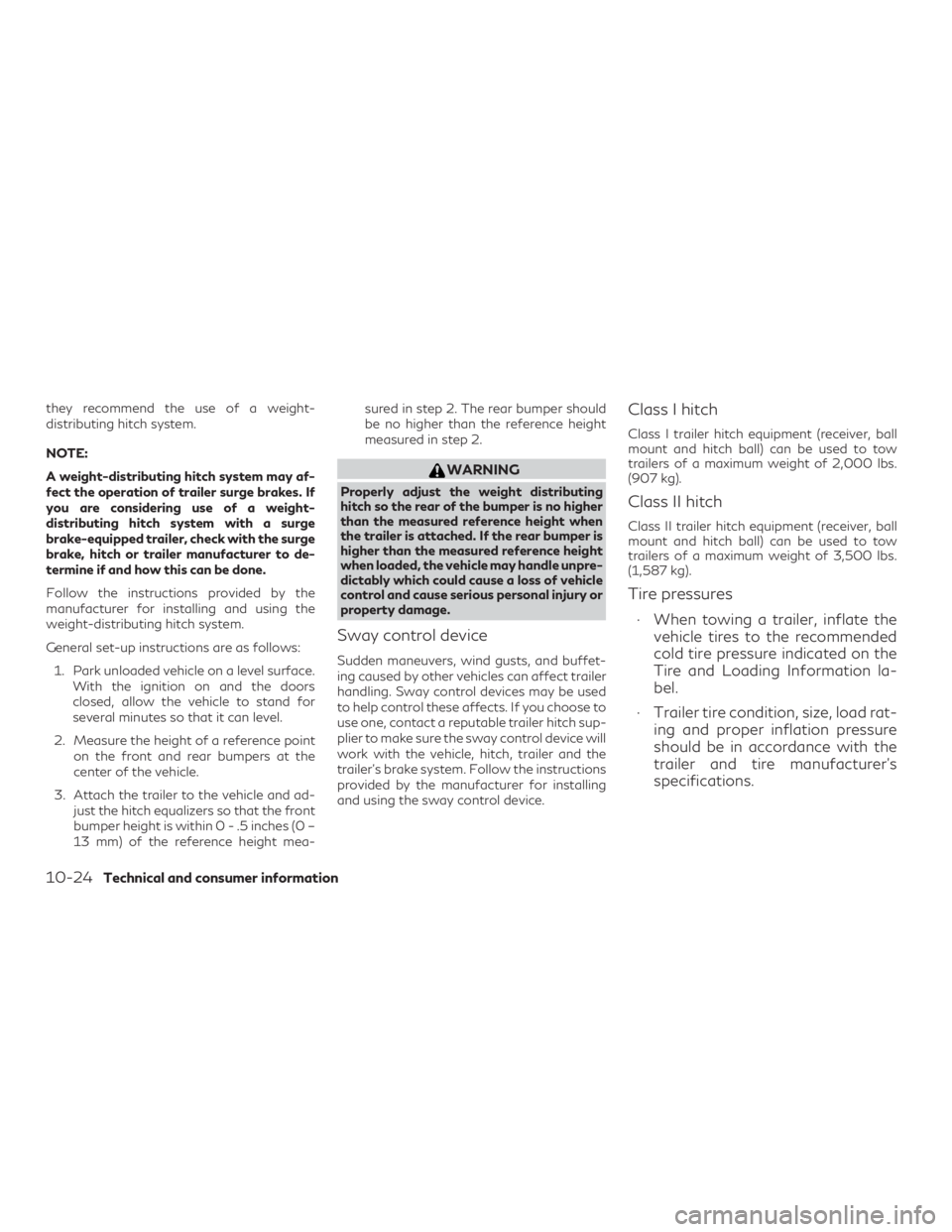
they recommend the use of a weight-
distributing hitch system.
NOTE:
A weight-distributing hitch system may af-
fect the operation of trailer surge brakes. If
you are considering use of a weight-
distributing hitch system with a surge
brake-equipped trailer, check with the surge
brake, hitch or trailer manufacturer to de-
termine if and how this can be done.
Follow the instructions provided by the
manufacturer for installing and using the
weight-distributing hitch system.
General set-up instructions are as follows:1. Park unloaded vehicle on a level surface. With the ignition on and the doors
closed, allow the vehicle to stand for
several minutes so that it can level.
2. Measure the height of a reference point on the front and rear bumpers at the
center of the vehicle.
3. Attach the trailer to the vehicle and ad- just the hitch equalizers so that the front
bumper height is within0-.5inches (0 –
13 mm) of the reference height mea- sured in step 2. The rear bumper should
be no higher than the reference height
measured in step 2.
WARNING
Properly adjust the weight distributing
hitch so the rear of the bumper is no higher
than the measured reference height when
the trailer is attached. If the rear bumper is
higher than the measured reference height
when loaded, the vehicle may handle unpre-
dictably which could cause a loss of vehicle
control and cause serious personal injury or
property damage.
Sway control device
Sudden maneuvers, wind gusts, and buffet-
ing caused by other vehicles can affect trailer
handling. Sway control devices may be used
to help control these affects. If you choose to
use one, contact a reputable trailer hitch sup-
plier to make sure the sway control device will
work with the vehicle, hitch, trailer and the
trailer’s brake system. Follow the instructions
provided by the manufacturer for installing
and using the sway control device.
Class I hitch
Class I trailer hitch equipment (receiver, ball
mount and hitch ball) can be used to tow
trailers of a maximum weight of 2,000 lbs.
(907 kg).
Class II hitch
Class II trailer hitch equipment (receiver, ball
mount and hitch ball) can be used to tow
trailers of a maximum weight of 3,500 lbs.
(1,587 kg).
Tire pressures
∙ When towing a trailer, inflate the
vehicle tires to the recommended
cold tire pressure indicated on the
Tire and Loading Information la-
bel.
∙ Trailer tire condition, size, load rat- ing and proper inflation pressure
should be in accordance with the
trailer and tire manufacturer’s
specifications.
10-24
Technical and consumer information
Page 555 of 580
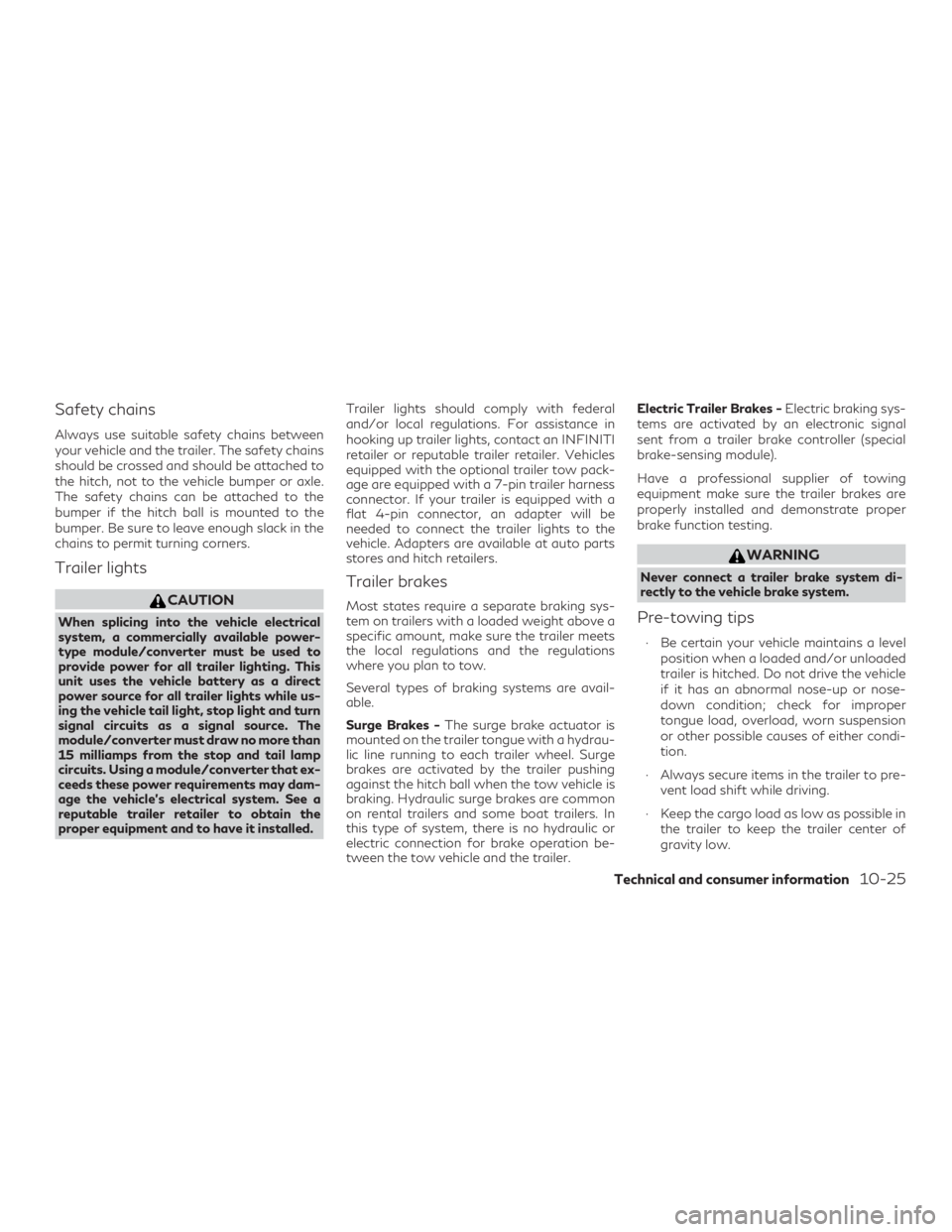
Safety chains
Always use suitable safety chains between
your vehicle and the trailer. The safety chains
should be crossed and should be attached to
the hitch, not to the vehicle bumper or axle.
The safety chains can be attached to the
bumper if the hitch ball is mounted to the
bumper. Be sure to leave enough slack in the
chains to permit turning corners.
Trailer lights
CAUTION
When splicing into the vehicle electrical
system, a commercially available power-
type module/converter must be used to
provide power for all trailer lighting. This
unit uses the vehicle battery as a direct
power source for all trailer lights while us-
ing the vehicle tail light, stop light and turn
signal circuits as a signal source. The
module/converter must draw no more than
15 milliamps from the stop and tail lamp
circuits. Using a module/converter that ex-
ceeds these power requirements may dam-
age the vehicle’s electrical system. See a
reputable trailer retailer to obtain the
proper equipment and to have it installed.Trailer lights should comply with federal
and/or local regulations. For assistance in
hooking up trailer lights, contact an INFINITI
retailer or reputable trailer retailer. Vehicles
equipped with the optional trailer tow pack-
age are equipped with a 7-pin trailer harness
connector. If your trailer is equipped with a
flat 4-pin connector, an adapter will be
needed to connect the trailer lights to the
vehicle. Adapters are available at auto parts
stores and hitch retailers.
Trailer brakes
Most states require a separate braking sys-
tem on trailers with a loaded weight above a
specific amount, make sure the trailer meets
the local regulations and the regulations
where you plan to tow.
Several types of braking systems are avail-
able.
Surge Brakes -
The surge brake actuator is
mounted on the trailer tongue with a hydrau-
lic line running to each trailer wheel. Surge
brakes are activated by the trailer pushing
against the hitch ball when the tow vehicle is
braking. Hydraulic surge brakes are common
on rental trailers and some boat trailers. In
this type of system, there is no hydraulic or
electric connection for brake operation be-
tween the tow vehicle and the trailer. Electric Trailer Brakes -
Electric braking sys-
tems are activated by an electronic signal
sent from a trailer brake controller (special
brake-sensing module).
Have a professional supplier of towing
equipment make sure the trailer brakes are
properly installed and demonstrate proper
brake function testing.
WARNING
Never connect a trailer brake system di-
rectly to the vehicle brake system.
Pre-towing tips
∙ Be certain your vehicle maintains a level position when a loaded and/or unloaded
trailer is hitched. Do not drive the vehicle
if it has an abnormal nose-up or nose-
down condition; check for improper
tongue load, overload, worn suspension
or other possible causes of either condi-
tion.
∙ Always secure items in the trailer to pre- vent load shift while driving.
∙ Keep the cargo load as low as possible in the trailer to keep the trailer center of
gravity low.
Technical and consumer information10-25
Page 557 of 580
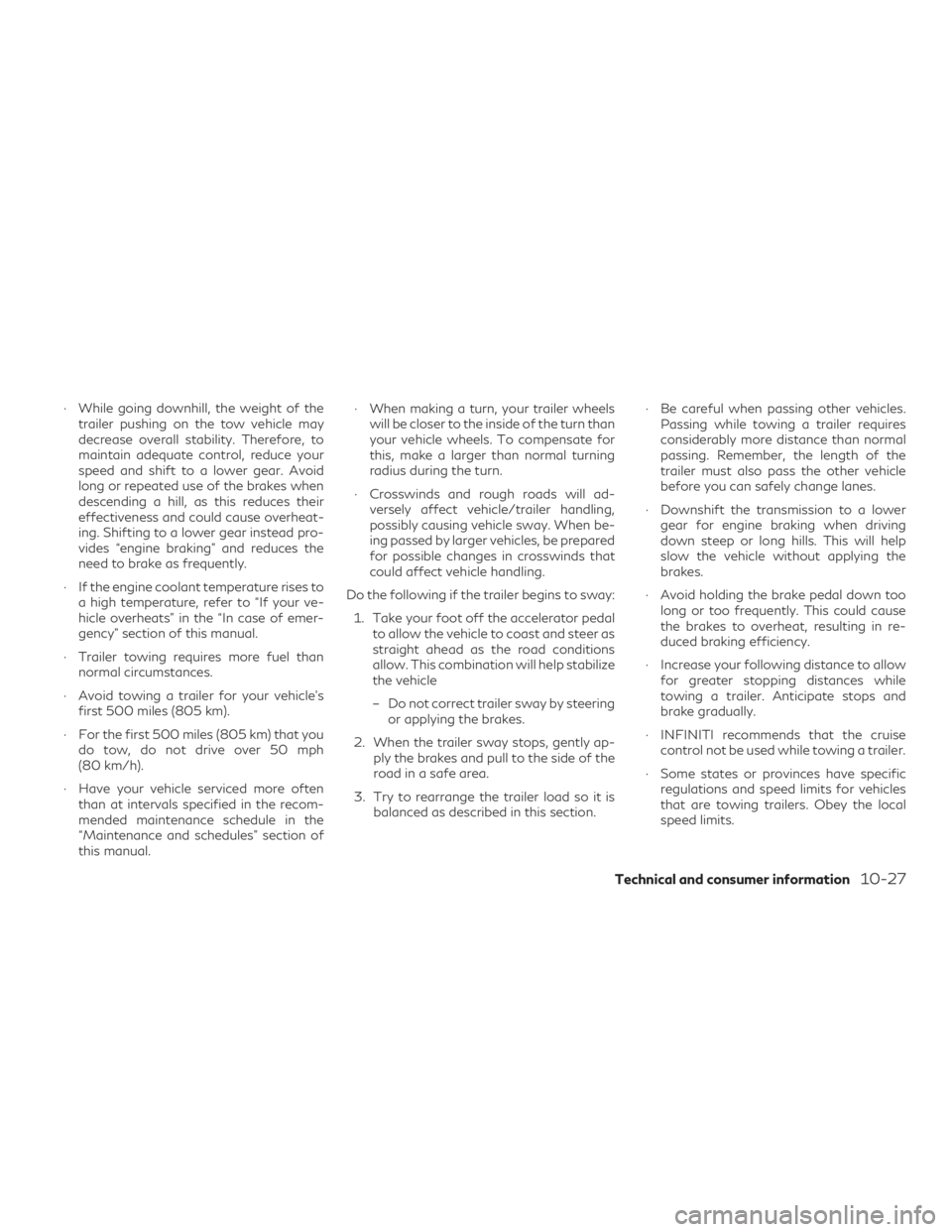
∙ While going downhill, the weight of thetrailer pushing on the tow vehicle may
decrease overall stability. Therefore, to
maintain adequate control, reduce your
speed and shift to a lower gear. Avoid
long or repeated use of the brakes when
descending a hill, as this reduces their
effectiveness and could cause overheat-
ing. Shifting to a lower gear instead pro-
vides “engine braking” and reduces the
need to brake as frequently.
∙ If the engine coolant temperature rises to a high temperature, refer to “If your ve-
hicle overheats” in the “In case of emer-
gency” section of this manual.
∙ Trailer towing requires more fuel than normal circumstances.
∙ Avoid towing a trailer for your vehicle’s first 500 miles (805 km).
∙ For the first 500 miles (805 km) that you do tow, do not drive over 50 mph
(80 km/h).
∙ Have your vehicle serviced more often than at intervals specified in the recom-
mended maintenance schedule in the
“Maintenance and schedules” section of
this manual. ∙ When making a turn, your trailer wheels
will be closer to the inside of the turn than
your vehicle wheels. To compensate for
this, make a larger than normal turning
radius during the turn.
∙ Crosswinds and rough roads will ad- versely affect vehicle/trailer handling,
possibly causing vehicle sway. When be-
ing passed by larger vehicles, be prepared
for possible changes in crosswinds that
could affect vehicle handling.
Do the following if the trailer begins to sway: 1. Take your foot off the accelerator pedal to allow the vehicle to coast and steer as
straight ahead as the road conditions
allow. This combination will help stabilize
the vehicle
– Do not correct trailer sway by steering or applying the brakes.
2. When the trailer sway stops, gently ap- ply the brakes and pull to the side of the
road in a safe area.
3. Try to rearrange the trailer load so it is balanced as described in this section. ∙ Be careful when passing other vehicles.
Passing while towing a trailer requires
considerably more distance than normal
passing. Remember, the length of the
trailer must also pass the other vehicle
before you can safely change lanes.
∙ Downshift the transmission to a lower gear for engine braking when driving
down steep or long hills. This will help
slow the vehicle without applying the
brakes.
∙ Avoid holding the brake pedal down too long or too frequently. This could cause
the brakes to overheat, resulting in re-
duced braking efficiency.
∙ Increase your following distance to allow for greater stopping distances while
towing a trailer. Anticipate stops and
brake gradually.
∙ INFINITI recommends that the cruise control not be used while towing a trailer.
∙ Some states or provinces have specific regulations and speed limits for vehicles
that are towing trailers. Obey the local
speed limits.
Technical and consumer information10-27
Page 566 of 580
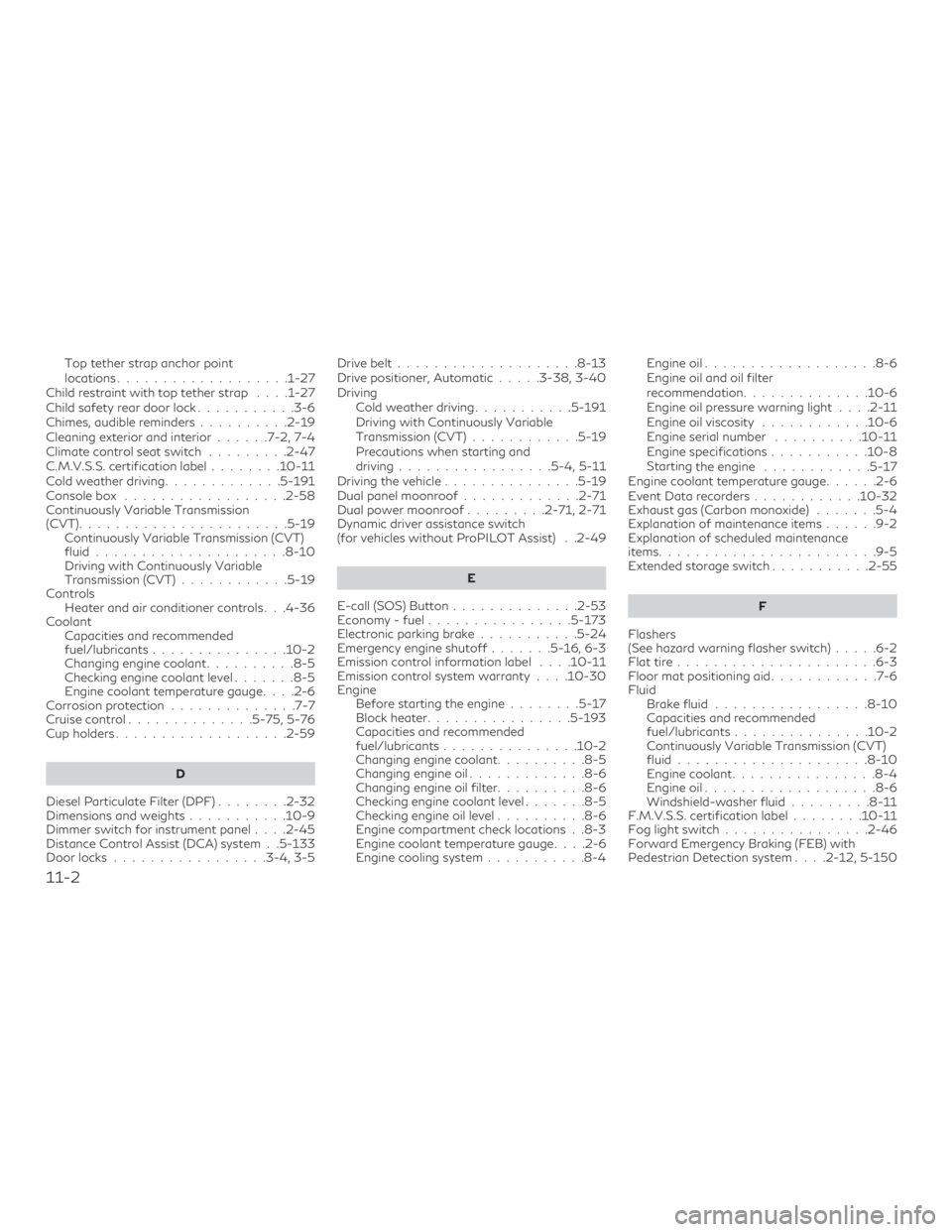
Top tether strap anchor point
locations...................1-27
Child restraint with top tether strap ....1-27
Child safety rear door lock ...........3-6
Chimes, audible reminders ..........2-19
Cleaning exterior and interior ......7-2,7-4
Climate control seat switch .........2-47
C.M.V.S.S. certification label ........10-11
Cold weather driving .............5-191
Console box ..................2-58
Continuously Variable Transmission
(CVT) .......................5-19
Continuously Variable Transmission (CVT)
fluid.....................8-10
Driving with Continuously Variable
Transmission (CVT) ............5-19
Controls Heater and air conditioner controls . . .4-36
Coolant Capacities and recommended
fuel/lubricants...............10-2
Changing engine coolant ..........8-5
Checking engine coolant level .......8-5
Engine coolant temperature gauge ....2-6
Corrosion protection ..............7-7
Cruisecontrol..............5-75,5-76
Cupholders...................2-59
D
Diesel Particulate Filter (DPF) ........2-32
Dimensionsandweights...........10-9
Dimmer switch for instrument panel ....2-45
Distance Control Assist (DCA) system . .5-133
Door locks .................3-4,3-5 Drivebelt....................8-13
Drive positioner, Automatic
.....3-38,3-40
Driving Cold weather driving ...........5-191
Driving with Continuously Variable
Transmission (CVT) ............5-19
Precautions when starting and
driving .................5-4,5-11
Driving the vehicle ...............5-19
Dual panel moonroof .............2-71
Dual power moonroof .........2-71,2-71
Dynamic driver assistance switch
(for vehicles without ProPILOT Assist) . .2-49
E
E-call (SOS) Button ..............2-53
Economy - fuel ................5-173
Electronic parking brake ...........5-24
Emergency engine shutoff .......5-16,6-3
Emission control information label ....10-11
Emission control system warranty ....10-30
Engine Before starting the engine ........5-17
Block heater ................5-193
Capacities and recommended
fuel/lubricants...............10-2
Changing engine coolant ..........8-5
Changing engine oil .............8-6
Changing engine oil filter ..........8-6
Checking engine coolant level .......8-5
Checking engine oil level ..........8-6
Engine compartment check locations . .8-3
Engine coolant temperature gauge ....2-6
Engine cooling system ...........8-4 Engine oil
...................8-6
Engine oil and oil filter
recommendation ..............10-6
Engine oil pressure warning light ....2-11
Engine oil viscosity ............10-6
Engine serial number ..........10-11
Engine specifications ...........10-8
Starting the
engine ............5-17
Engine coolant temperature gauge ......2-6
Event Data recorders ............10-32
Exhaust gas (Carbon monoxide) .......5-4
Explanation of maintenance items ......9-2
Explanation of scheduled maintenance
items........................9-5
Extended storage switch ...........2-55
F
Flashers
(See hazard warning flasher switch) .....6-2
Flat tire ......................6-3
Floor mat positioning aid ............7-6
Fluid Brakefluid .................8-10
Capacities and recommended
fuel/lubricants............... 10-2
Continuously Variable Transmission (CVT)
fluid.....................8-10
Engine coolant ................8-4
Engine oil ...................8-6
Windshield-washerfluid.........8-11
F.M.V.S.S. certification label ........10-11
Fog light switch ................2-46
Forward Emergency Braking (FEB) with
Pedestrian Detection system ....2-12,5-150
11-2
Page 571 of 580
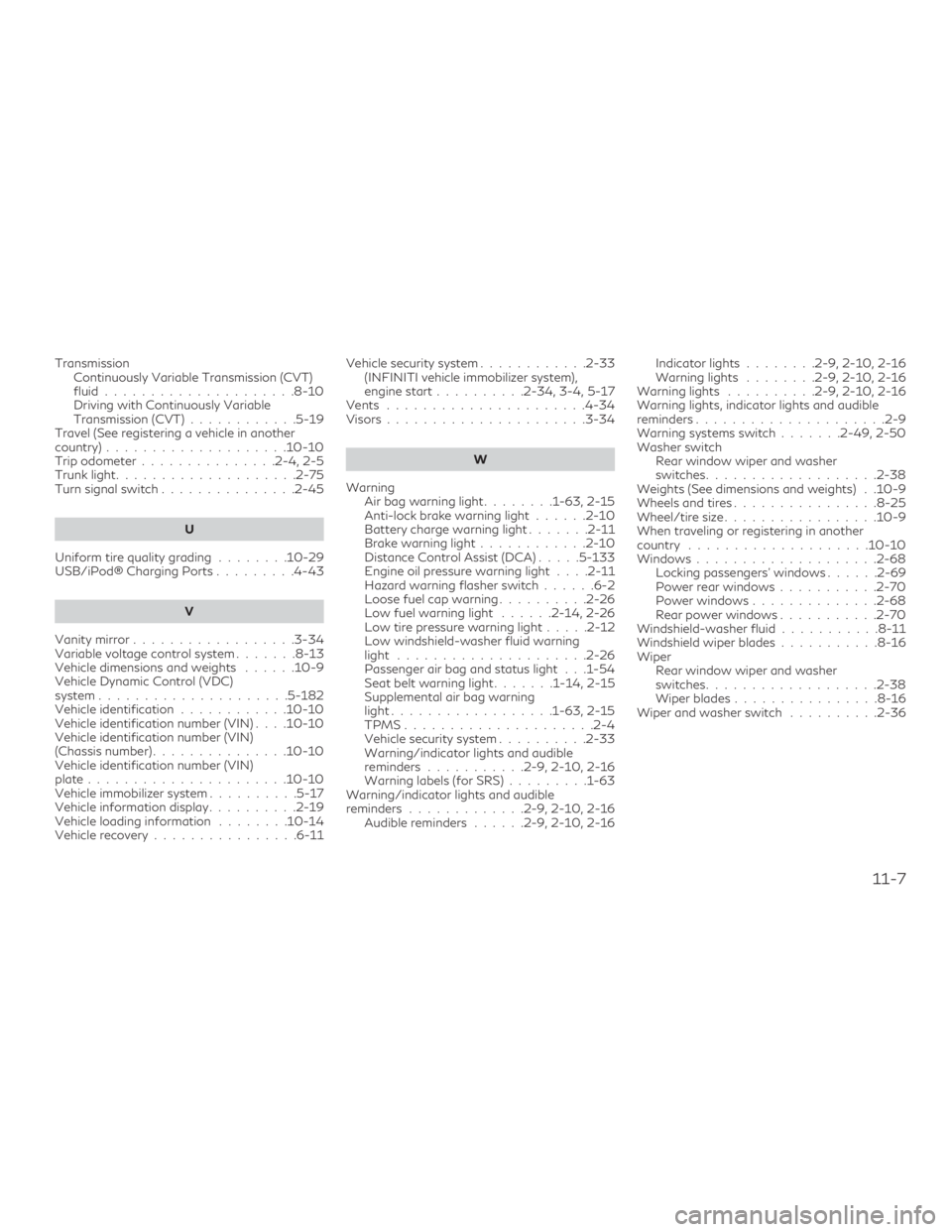
TransmissionContinuously Variable Transmission (CVT)
fluid.....................8-10
Driving with Continuously Variable
Transmission (CVT) ............5-19
Travel (See registering a vehicle in another
country) ....................10-10
Trip odometer ...............2-4,2-5
Trunklight....................2-75
Turn signal switch ...............2-45
U
Uniform tire quality grading ........10-29
USB/iPod® Charging Ports .........4-43
V
Vanity mirror ..................3-34
Variable voltage control system .......8-13
Vehicle dimensions and weights ......10-9
Vehicle Dynamic Control (VDC)
system.....................5-182
Vehicle identification ............10-10
Vehicle identification number (VIN) ....10-10
Vehicle identification number (VIN)
(Chassis number) ...............10-10
Vehicle identification number (VIN)
plate......................10-10
Vehicle immobilizer system ..........5-17
Vehicle information display ..........2-19
Vehicle loading information ........10-14
Vehicle recovery ................6-11 Vehicle security system
............2-33
(INFINITI vehicle immobilizer system),
engine start ..........2-34,3-4,5-17
Vents ......................4-34
Visors......................3-34
W
Warning Airbagwarninglight........1-63,2-15
Anti-lock brake warning light ......2-10
Batterychargewarninglight.......2-11
Brakewarninglight............2-10
Distance Control Assist (DCA) .....5-133
Engine oil pressure warning light ....2-11
Hazard warning flasher switch ......6-2
Loose fuel cap warning ..........2-26
Lowfuelwarninglight ......2-14,2-26
Low tire pressure warning light .....2-12
Low windshield-washer fluid warning
light .....................2-26
Passenger air bag and status light . . .1-54
Seat belt warning light .......1-14,2-15
Supplemental air bag warning
light..................1-63,2-15
TPMS .....................2-4
Vehicle security system ..........2-33
Warning/indicator lights and audible
reminders ...........2-9,2-10,2-16
Warning labels (for SRS) .........1-63
Warning/indicator lights and audible
reminders .............2-9,2-10,2-16
Audible reminders ......2-9,2-10,2-16 Indicatorlights........2-9,2-10,2-16
Warninglights ........2-9,2-10,2-16
Warninglights ..........2-9,2-10,2-16
Warning lights, indicator lights and audible
reminders.....................2-9
Warning systems switch .......2-49,2-50
Washer switch Rear window wiper and washer
switches................... 2-38
Weights (See dimensions and weights) . .10-9
Wheels and tires ................8-25
Wheel/tire size .................10-9
When traveling or registering in another
country .................... 10-10
Windows ....................2-68
Locking passengers' windows ......2-69
Power rear windows ...........2-70
Power windows .............. 2-68
Rear power windows ...........2-70
Windshield-washerfluid...........8-11
Windshieldwiperblades...........8-16
Wiper Rear window wiper and washer
switches................... 2-38
Wiperblades................8-16
Wiper and washer switch ..........2-36
11-7